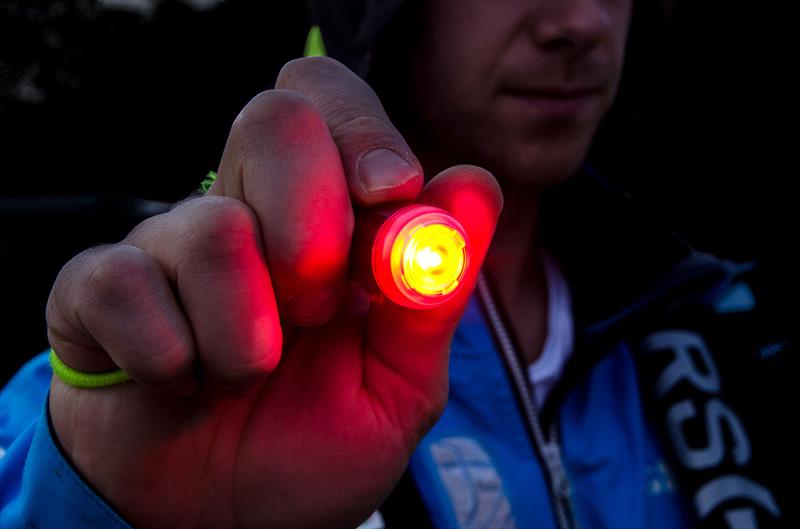
SpotME and OLAS: More innovations from Exposure Lights
by Mark Jardine 21 Dec 2016 09:05 GMT
21 December 2016

Exposure SpotMe strobe in hand © Exposure Lights
We spoke to Tom Harrop at Exposure Lights about the Spot Me mini strobe and the OLAS App which they launched at the METS Trade Show in Amsterdam.
Mark: Tom, could you first tell us a bit about the SpotMe mini strobe?
Tom: The SpotMe is designed for dinghy and yacht sailors as a really compact light to be worn on your life jacket or in your pocket, just so you always have something with you, day or night. You just simply squeeze the product, it blasts out a 250 lumen strobe light, which is visible over a 1,000 metres during the day. So, if you are in a troublesome capsize, or someone has just gone overboard and it's rough weather, it's an easy way to pick them out. The strobe is visible for 1km in broad daylight, and for over a nautical mile at night. It's a simple concept; aluminum construction and British made - just a reliable product, so you can get seen day or night.
Mark: What is the weight of this? I know on racing boats a lot of people are thinking about making sure that everything is down to a minimum weight.
Tom: It weighs just 35 grams. Because it's using lithium ion CR123 batteries and LED technology everything is getting miniaturized nowadays, so it's much lower than your average strobe light.
Mark: And here, brand-new, hot off the 3D printer, you have your OLAS system. This seems to be a novel approach to man overboard and ways of dealing with that situation. How does the OLAS system work?
Tom: OLAS is a very cost effective, smart man overboard system. So you're connecting a 'virtual' tag so to speak, essentially a personnel tag or pull light tag to your phone or iPad. You register it, you name your tags, so if you've got multiple crew you can have tags for Tom, Mark and so on. As soon as that tag becomes disconnected from your device, your phone or your tablet, it sounds an alarm, logs the coordinates and gives a really simple, large arrow back to those coordinates. And then as you scroll across, it also gives you a course over ground (COG). So you match your course over ground and arrow back to your lost crew's location and that should bring you back to the coordinates where the man overboard occurred.
The screens give you the coordinates, the time, and your current coordinates, which is the information required by the Coast Guard and Lifeboats when you're calling in a man overboard incident. It also gives you directions on what to say over your VHF; go to channel 16 and then it runs you through the exact distress call protocol, including integrating the latitude and longitude. If you've pre-entered your vessel information it also puts that straight onto the screen. In a time of distress you get confusion, so OLAS is just keeping it really simple, aiding in an effective MOB recovery.
Mark: So effectively using the technology; the Bluetooth and the computing power that's already available in your mobile phone, and then using very cheap hardware and then using the distances involved with an OLAS wristband, when it is a certain distance away from the phone, it will just log that position?
Tom: As soon as the tag gets disconnected from the phone essentially, the phone logs the position coordinates. The tag will lose that connection as soon as it's submerged, so if you've gone overboard then your device immediately activates an alarm. If someone is below decks doing the cooking or putting on the tea, they will instantly know if you've gone overboard, so they can react quickly. Hopefully, they don't have to do a May Day call because they can see you straight away.
Mark: The final product here looks like a combination of your SpotMe strobe and the OLAS system. I know this is in a prototype stage at the moment, but can you explain a bit about that?
Tom: Very much so. We've made the technology from our MOB light, which won the Dame Award three years ago, far more compact so that it can easily attach to a life jacket or in your pocket. It floats and as soon as you throw it into the water it also turns on to its strobe mode. You can use it as a USB rechargeable torch. It also has smart Bluetooth low energy connectivity to your mobile device, so it has the advantages of OLAS, the advantages of MOB technology and water activated strobe technology, and the standard advantages of an LED light, all into one compact unit.
Mark: It's great to see a British company and British manufacturing creating such innovative products, many thanks for your time Tom.
Tom: Thanks you very much Mark, good to see you.
For more information visit http://www.alertandfind.com/ and exposurelights.com/marine-lights